British Airways
|
| |||||||
| |||||||
| Founded | 31 March 1974 | ||||||
|---|---|---|---|---|---|---|---|
| AOC # | 441 | ||||||
| Hubs |
| ||||||
| Frequent-flyer program | Executive Club/Avios | ||||||
| Airport lounge |
| ||||||
| Alliance | Oneworld | ||||||
| Subsidiaries | |||||||
| Fleet size | 295 | ||||||
| Destinations | 183 | ||||||
| Company slogan | To Fly. To Serve. | ||||||
| Parent company | International Airlines Group | ||||||
| Headquarters | Waterside, Harmondsworth, England | ||||||
| Key people | Alex Cruz, CEO and chairman[3] | ||||||
| Revenue |
| ||||||
| Website |
britishairways | ||||||
British Airways, often shortened to BA, is the flag carrier and the largest airline in the United Kingdom based on fleet size. When measured by passengers carried, it is second-largest in the United Kingdom behind easyJet. The airline is based in Waterside near its main hub at London Heathrow Airport.
A British Airways Board was established by the United Kingdom government in 1972 to manage the two nationalised airline corporations, British Overseas Airways Corporation and British European Airways, and two smaller, regional airlines, Cambrian Airways, from Cardiff, and Northeast Airlines, from Newcastle upon Tyne. On 31 March 1974, all four companies were merged to form British Airways. After almost 13 years as a state company, British Airways was privatised in February 1987 as part of a wider privatisation plan by the Conservative government. The carrier soon expanded with the acquisition of British Caledonian in 1987, followed by Dan-Air in 1992 and British Midland International in 2012.
British Airways is a founding member of the Oneworld airline alliance, along with American Airlines, Cathay Pacific, Qantas, and the now defunct Canadian Airlines. The alliance has since grown to become the third-largest, after SkyTeam and Star Alliance. British Airways merged with Iberia on 21 January 2011, formally creating the International Airlines Group (IAG), the world's third-largest airline group in terms of annual revenue and the second-largest in Europe. IAG is listed on the London Stock Exchange and in the FTSE 100 Index.
A long-time Boeing customer, British Airways ordered 59 Airbus A320 family aircraft in August 1998. In 2007 it purchased 12 Airbus A380s and 24 Boeing 787 Dreamliners, marking the start of its long-haul fleet replacement. The centrepiece of the airline's long-haul fleet is the Boeing 777, with 58 in the fleet. British Airways is the largest operator of the Boeing 747-400 in the world, with 51 registered to the airline.
History

In January 1972, a British Airways Board was established by the United Kingdom government following the passing of the Civil Aviation Act of 1971, to manage British Overseas Airways Corporation (BOAC) and British European Airways (BEA). On 1 September 1972 the management service functions of both BOAC and BEA were combined under the newly formed British Airways Group.
British Airways was established as an airline on 31 March 1974 by the dissolution of BOAC and BEA.[5] Following two years of fierce competition with British Caledonian, the second-largest airline in the United Kingdom at the time, the Government changed its aviation policy in 1976 so that the two carriers would no longer compete on long-haul routes.[6]
British Airways and Air France operated the supersonic airliner Aerospatiale-BAC Concorde, and the world's first supersonic passenger service flew in January 1976 from London Heathrow to Bahrain.[7] Services to the US began on 24 May 1976 with a flight to Washington Dulles airport, and flights to New York JFK airport followed on 22 September 1977. Service to Singapore was established in co-operation with Singapore Airlines as a continuation of the flight to Bahrain.[5] Following the Air France Concorde crash in Paris and a slump in air travel following the 11 September attacks in New York in 2001, it was decided to cease Concorde operations in 2003 after 27 years of service. The final commercial Concorde flight was BA002 from New York JFK to London Heathrow on 24 October 2003.[8]
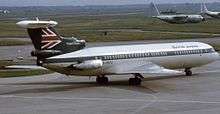
In 1981 the airline was instructed to prepare for privatisation by the Conservative Thatcher government. Sir John King, later Lord King, was appointed chairman, charged with bringing the airline back into profitability. While many other large airlines struggled, King was credited with transforming British Airways into one of the most profitable air carriers in the world.[9] The flag carrier was privatised and was floated on the London Stock Exchange in February 1987.[10] British Airways effected the takeover of the UK's "second" airline, British Caledonian, in July of that same year.[11]
The formation of Richard Branson's Virgin Atlantic Airways in 1984 created a competitor for BA. The intense rivalry between British Airways and Virgin Atlantic culminated in the former being sued for libel in 1993, arising from claims and counter claims over a "dirty tricks" campaign against Virgin. This campaign included allegations of poaching Virgin Atlantic customers, tampering with private files belonging to Virgin and undermining Virgin's reputation in the City. As a result of the case BA management apologised "unreservedly", and the company agreed to pay £110,000 damages to Virgin, £500,000 to Branson personally and £3 million legal costs.[12] Lord King stepped down as chairman in 1993 and was replaced by his deputy, Colin Marshall, while Bob Ayling took over as CEO.[13] Virgin filed a separate action in the US that same year regarding BA's domination of the trans-Atlantic routes, but it was thrown out in 1999.[12]
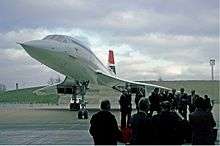
In 1992 British Airways expanded through the acquisition of the financially troubled Dan-Air, giving BA a much larger presence at Gatwick airport. British Asia Airways, a subsidiary based in Taiwan, was formed in March 1993 to operate between London and Taipei. That same month BA purchased a 25% stake in the Australian airline Qantas and, with the acquisition of Brymon Airways in May, formed British Airways Citiexpress (later BA Connect).[13] In September 1998, British Airways, along with American Airlines, Cathay Pacific, Qantas, and Canadian Airlines, formed the Oneworld airline alliance. Oneworld began operations on 1 February 1999, and is the third largest airline alliance in the world, behind SkyTeam and Star Alliance.[11]
Bob Ayling's leadership led to a cost savings of £750m and the establishment of a budget airline, Go, in 1998.[14] The next year, however, British Airways reported an 84% drop in profits in its first quarter alone, its worst in seven years.[15] In March 2000, Ayling was removed from his position and British Airways announced Rod Eddington as his successor. That year, British Airways and KLM conducted talks on a potential merger, reaching a decision in July to file an official merger plan with the European Commission.[16] The plan fell through in September 2000.[17] British Asia Airways ceased operations in 2001 after BA suspended flights to Taipei. Go was sold to its management and the private equity firm 3i in June 2001.[18] Eddington would make further workforce cuts due to reduced demand following 11 September attacks in 2001,[8] and BA sold its stake in Qantas in September 2004.[19] In 2005 Willie Walsh, managing director of Aer Lingus and a former pilot, became the chief executive officer of British Airways.[20] BA unveiled its new subsidiary OpenSkies in January 2008, taking advantage of the liberalisation of transatlantic traffic rights between Europe and the United States. OpenSkies flies non-stop from Paris to New York's JFK and Newark airports.[21]
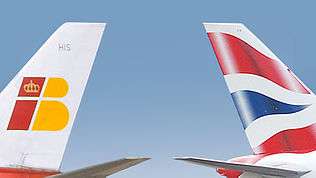
On July 2008 British Airways announced a merger plan with Iberia, another flag carrier airline in the Oneworld alliance, wherein each airline would retain its original brand.[22] The agreement was confirmed in April 2010,[23] and in July the European Commission and US Department of Transport permitted the merger and began to co-ordinate transatlantic routes with American Airlines.[24][25] On 6 October 2010 the alliance between British Airways, American Airlines and Iberia formally began operations. The alliance generates an estimated £230 million in annual cost-saving for BA, in addition to the £330 million which would be saved by the merger with Iberia.[26][27] This merger was finalised on 21 January 2011, resulting in the International Airlines Group (IAG), the world's third-largest airline in terms of annual revenue and the second-largest airline group in Europe.[23][28] Prior to merging, British Airways owned a 13.5% stake in Iberia, and thus received ownership of 55% of the combined International Airlines Group; Iberia's other shareholders received the remaining 45%.[29] As a part of the merger, British Airways ceased trading independently on the London Stock Exchange after 23 years as a constituent of the FTSE 100 Index.[30]
In September 2010 Willie Walsh, now CEO of IAG, announced that the group was considering acquiring other airlines and had drawn up a shortlist of twelve possible acquisitions.[31] In November 2011 IAG announced an agreement in principle to purchase British Midland International from Lufthansa.[32] A contract to purchase the airline was agreed the next month,[33] and the sale was completed for £172.5 million on 30 March 2012.[34] The airline established a new subsidiary based at London City Airport operating Airbus A318s.[35]
British Airways was the official airline partner of the London 2012 Olympic Games. On 18 May 2012 it flew the Olympic flame from Athens International Airport to RNAS Culdrose while carrying various dignitaries, including Lord Sebastian Coe, Princess Anne, the Olympics minister Hugh Robertson and the London Mayor Boris Johnson, along with the footballer David Beckham.[36]
Corporate affairs
Operations
British Airways is the largest airline based in the United Kingdom in terms of fleet size, international flights, and international destinations and was, until 2008, the largest airline by passenger numbers. The airline carried 34.6 million passengers in 2008, but, rival carrier easyJet transported 44.5 million passengers that year, passing British Airways for the first time.[37][38] British Airways holds a United Kingdom Civil Aviation Authority Type A Operating Licence, it is permitted to carry passengers, cargo, and mail on aircraft with 20 or more seats.[39]
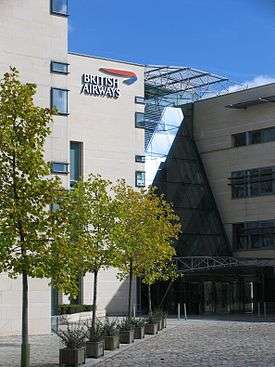
The airlines' head office, Waterside, stands in Harmondsworth, a village that is near London Heathrow Airport.[40] Waterside was completed in June 1998 to replace British Airways' previous head office, Speedbird House, which was located on the grounds of Heathrow.[41][42]
British Airways' main base is at London Heathrow Airport, but it also has a major presence at Gatwick Airport. It also has a base at London City Airport (LCY), where its subsidiary BA CityFlyer is the largest operator. BA had previously operated a significant hub at Manchester Airport. Manchester to New York (JFK) services were withdrawn; later all international services outside London ceased when the subsidiary BA Connect was sold. Passengers wishing to travel internationally with BA either to or from regional UK destinations must now transfer in London.[43] Heathrow Airport is dominated by British Airways, which owns 40% of the slots available at the airport.[44] The majority of BA services operate from Terminal 5, with the exception of some short-haul and mid-haul flights at Terminal 1 arising from the purchase of BMI and some short-haul flights at Terminal 3,[45] owing to a lack of capacity at Terminal 5. With the imminent opening of the brand-new Terminal 2 in 2014, Star Alliance airlines will progressively be moving all their services into the new terminal and Terminal 1 will be closed for demolition in due course. British Airways' services will then be concentrated in Terminals 3 and 5.
In August 2014 Willie Walsh advised the airline would continue to use flight paths over Iraq despite the hostilities there. A few days earlier Qantas announced it would avoid Iraqi airspace, while other airlines did likewise. The issue arose following the downing of Malaysia Airlines Flight 17 over Ukraine, and a temporary suspension of flights to and from Ben Gurion Airport during the 2014 Israel–Gaza conflict.[46]
Subsidiaries and shareholdings
BA CityFlyer, a wholly owned subsidiary, offers flights from its base at London City Airport to 23 destinations throughout Europe. It flies 17 Embraer E-170/E-190 aircraft and two leased Saab 2000.[47] The airline focuses on serving the financial market, though it has recently expanded into the leisure market, offering routes to Ibiza, Palma and Venice.[48] The onboard product is identical to that of the BA Short Haul product from both LHR and LGW.[49]
In March 2015, Qatar Airways purchased a 10% stake in International Airlines Group, the parent of British Airways and Iberia, for €1.2 billion (US$1.26 billion).[50]
BEA Helicopters was renamed British Airways Helicopters in 1974 and operated passenger and offshore oil support services until it was sold in 1986.[51] Other former subsidiaries include the German airline Deutsche BA from 1997 until 2003 and the French airline Air Liberté from 1997 to 2001.[52][53] British Airways also owned Airways Aero Association, the operator of the British Airways flying club based at Wycombe Air Park in High Wycombe, until it was sold to Surinder Arora in 2007.[54]
South Africa's Comair and Denmark's Sun Air of Scandinavia have been franchisees of British Airways since 1996.[55][56] British Airways obtained a 15% stake in UK regional airline Flybe from the sale of BA Connect in March 2007.[57] It sold the stake in 2014. BA also owned a 10% stake in InterCapital and Regional Rail (ICRR), the company that managed the operations of Eurostar (UK) Ltd from 1998 to 2010,[58][59] when the management of Eurostar was restructured.
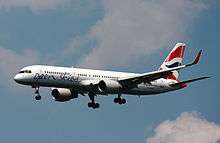
With the creation of an Open Skies agreement between Europe and the United States in March 2008, British Airways started a new subsidiary airline called OpenSkies (previously known as "Project Lauren").[60] The airline started operations in June 2008, and now flies direct from Paris to New York's JFK and Newark airports.[61]
British Airways Limited was established in 2012 to take over the operation of the premium service between London City Airport and New York-JFK. BA began the service in September 2009, using two Airbus A318s fitted with 32 lie-flat beds in an all business class cabin.[62][63] Flights operate under the numbers previously reserved for Concorde: BA001 — BA004.[64][65]
British Airways provides cargo services under the British Airways World Cargo brand. The division has been part of IAG Cargo since 2012, and is the world's twelfth-largest cargo airline based on total freight tonne-kilometres flown.[66] BA World Cargo operates using the main BA fleet. Until the end of March 2014 they also operated three Boeing 747-8 freighter aircraft providing dedicated long-haul services under a wet lease arrangement from Global Supply Systems.[67] The division operates an automated cargo centre at London Heathrow Airport and handles freight at Gatwick and Stansted airports.
Business trends
The key trends for the British Airways Plc Group are shown below.
On the merger with Iberia, the accounting reference date was changed from 31 March to 31 December; figures below are therefore for the years to 31 March up to 2010, for the nine months to 31 December 2010, and for the years to 31 December thereafter:
| 2008 Mar |
2009 Mar |
2010 Mar |
2010 | 2011 | 2012 | 2013 | 2014 | 2015 | |
|---|---|---|---|---|---|---|---|---|---|
| Turnover (£m) | 8,758 | 8,992 | 7,994 | 6,683 | 9,987 | 10,827 | 11,421 | 11,719 | 11,333 |
| Profit (profit/loss after tax) (£m) | 694 | −358 | −425 | 170 | 672 | 84 | 281 | 702 | 975* |
| Number of employees (average FTE) | 41,745 | 41,473 | 37,595 | 35,778 | 36,164 | 38,761 | 38,592 | 39,710 | 39,309 |
| Number of passengers (m) | 34.6 | 33.1 | 31.8 | 24.1 | 34.2 | 37.6 | 39.9 | 41.5 | 43.3 |
| Passenger load factor (%) | 79.1 | 77.0 | 78.5 | 78.5 | 78.2 | 79.9 | 81.3 | 81.0 | 81.5 |
| Number of aircraft (at year end) | 245 | 245 | 238 | 240 | 245 | 273 | 278 | 279 | 284 |
| Notes/sources | [68][69] | [69] | [69] | [70] only 9 months |
[70] | [71] | [71] | [72] | *After deconsolidation of AGL [73] |
Industrial relations
Staff working for British Airways are represented by a number of trade unions, pilots are represented by British Air Line Pilots' Association, cabin crew by British Airlines Stewards and Stewardesses Association (a branch of Unite the Union), while other branches of Unite the Union and the GMB Union represent other employees. Bob Ayling's management faced strike action by cabin crew over a £1 billion cost-cutting drive to return BA to profitability in 1997; this was the last time BA cabin crew would strike until 2009, although staff morale has reportedly been unstable since that incident.[74] In an effort to increase interaction between management, employees, and the unions, various conferences and workshops have taken place, often with thousands in attendance.[75]
In 2005, wildcat action was taken by union members over a decision by Gate Gourmet not to renew the contracts of 670 workers and replace them with agency staff; it is estimated that the strike cost British Airways £30 million and caused disruption to 100,000 passengers.[76] In October 2006, BA became involved in a civil rights dispute when a Christian employee was forbidden to wear a necklace bearing the cross, a religious symbol.[77] BA's practice of forbidding such symbols has been publicly questioned by British politicians such as the former Home Secretary John Reid and the former Foreign Secretary Jack Straw.[78][79]
Relations have been turbulent between BA and Unite. In 2007, cabin crew threatened strike action over salary changes to be imposed by BA management. The strike was called off at the last minute, British Airways losing £80 million.[74] In December 2009, a ballot for strike action over Christmas received a high level of support,[80] action was blocked by a court injunction that deemed the ballot illegal. Negotiations failed to stop strike action in March, BA withdrew perks for strike participants.[81] Allegations were made by the Guardian newspaper that BA had consulted outside firms methods to undermine the unions, the story was later withdrawn.[82] A strike was announced for May 2010, British Airways again sought an injunction. Members of the Socialist Workers Party disrupted negotiations between BA management and Unite to prevent industrial action.[83] Further disruption struck when Derek Simpson, a Unite co-leader, was discovered to have leaked details of confidential negotiations online via Twitter.[84]
Destinations
British Airways serves over 160 destinations, including six domestic. It is one of the few airlines to fly to all six permanently inhabited continents,[85] along with Air China, Delta Air Lines, Emirates, Etihad Airways, Korean Air, Qantas, Qatar Airways, Singapore Airlines, South African Airways, United Airlines and Air Canada.
Codeshare agreements
British Airways codeshares with the following airlines:[86]
Alliance
British Airways is a member and one of the founders of Oneworld, an airline alliance.
Fleet

With the exception of the Boeing 707 and early Boeing 747 variants from BOAC, British Airways inherited a mainly UK-built fleet of aircraft when it was formed in 1974. The airline introduced the Boeing 737 and Boeing 757 into the fleet in the 1980s, followed by the Boeing 747-400, Boeing 767 and Boeing 777 in the 1990s. BA is now the largest operator of Boeing 747-400s, with 57 in its fleet.[11][13] Prior to the introduction of the 787, when Boeing built an aircraft for British Airways, it was allocated the customer code 36, which appeared in their aircraft designation as a suffix, such as 737–436.[87]
In 1991, British Airways placed its first order for 777-200 aircraft, ordering another four for fleet expansion in 2007 at a cost of around US$800 million.[88] BA's first 777s were fitted with General Electric GE90 engines, but BA switched to Rolls-Royce Trent 800s for subsequent aircraft.[89][90]
Later in 2007, BA announced their order of thirty-six new long-haul aircraft, including twelve Airbus A380s and twenty-four Boeing 787 Dreamliners.[91] Rolls-Royce Trent engines were again selected for both orders with Trent 900s powering the A380s and Trent 1000s powering the 787s. The Boeing 787s will replace 14 of British Airways' Boeing 767 fleet, while the Airbus A380s will replace 20 of BA's Boeing 747-400s and will most likely be used to increase capacity on key routes from London Heathrow.
On 1 August 2008, BA announced orders for six Boeing 777-300ERs and options for four more as an interim measure to cover for delays over the deliveries of their 787-8/9s. Of the six that have been ordered, four will be leased and two will be fully acquired by British Airways.[92]
On 22 April 2013, IAG confirmed that it had signed a memorandum of understanding to order 18 A350-1000 aircraft for British Airways, with an option for a further 18. The aircraft would replace some of the airline's fleet of Boeing 747-400s.[93] Options for 18 Boeing 787 aircraft, part of the original contract signed in 2007, have been converted into firm orders for delivery between 2017 and 2021.[94]
On 26 June 2013, British Airways took delivery of its first 787s. The aircraft began operations to Toronto on 1 September 2013, and began service to Newark on 1 October 2013.[95] BA's first A380 was delivered on 4 July 2013.[96] It began regular services to Los Angeles on 24 September 2013, followed by Hong Kong on 22 October 2013.[97]
The combined International Airlines Group entity (that BA is now a part of), operates around 400 aircraft, carries over 62 million passengers annually, and serves more than 200 destinations.[23]
Current fleet
.jpg)
.jpg)
.jpg)
.jpg)
As of September 2016, the British Airways fleet is made up of the following registered aircraft (including non-operational aircraft):[98][99]
| Aircraft | Number | Orders | Passengers | ||||
|---|---|---|---|---|---|---|---|
| F | J | W | Y | | |||
| Airbus A318-100 | 2 | — | — | 32 | — | — | 32 |
| Airbus A319-100 | 44 | — | — | var | — | var | 132 |
| — | var | — | var | 143 | |||
| — | var | — | var | 144 | |||
| Airbus A320-200 | 67 | — | — | var | — | var | 168 |
| — | var | — | var | 171 | |||
| Airbus A320neo | — | 25[100][101][102] | TBA | ||||
| Airbus A321-200 | 18 | — | — | var | — | var | 205 |
| — | 23 | — | 131 | 154 | |||
| Airbus A321neo | — | 10[100][101][102] | TBA | ||||
| Airbus A350-1000 | — | 18[103] | TBA | ||||
| Airbus A380-800 | 12 | — | 14 | 97 | 55 | 303 | 469 |
| Boeing 737-400 | 6[lower-alpha 1] | — | — | var | — | var | 149 |
| Boeing 747-400 | 51[lower-alpha 2] | — | 14 | 86 | 30 | 145 | 275 |
| 14 | 70 | 30 | 185 | 299 | |||
| 14 | 70 | 30 | 177 | 291 | |||
| 14 | 52 | 36 | 245 | 347 | |||
| Boeing 767-300ER | 15[lower-alpha 3] | — | — | 24 | 24 | 144 | 192 |
| — | var | — | var | 259 | |||
| Boeing 777-200 | 3 | — | 17 | 48 | 24 | 127 | 216 |
| Boeing 777-200ER | 43 | — | 14 | 48 | 40 | 124 | 226 |
| 12 | 48 | 32 | 127 | 219 | |||
| — | 48 | 24 | 203 | 275 | |||
| — | 40 | 24 | 219 | 283 | |||
| Boeing 777-300ER | 12 | — | 14 | 56 | 44 | 183 | 297 |
| Boeing 787-8 | 8 | 4[104] | — | 35 | 25 | 154 | 214 |
| Boeing 787-9 | 14 | 4[104] | 8 | 42 | 39 | 127 | 216 |
| Boeing 787-10 | — | 12[104] | TBA | ||||
| Total | 295 | 73 | |||||
Cargo fleet
IAG's cargo division, IAG Cargo, handles cargo operations using capacity on British Airways' passenger aircraft. IAG reached an agreement with Qatar Airways in 2014 to operate flights for IAG Cargo using Boeing 777F of Qatar Airways Cargo.[105]
British Airways World Cargo was the airline's freight division prior to its merger with Iberia Cargo to form IAG Cargo. Aircraft types used by the division between 1974 and 1983 were Vickers 953C,[106] Boeing 707-300C[107] and Boeing 747-200F[108] while the Boeing 747-400F was operated from the 1990s to 2001 through Atlas Air and 2002 to early 2012 by Global Supply Systems, of these only one of Atlas Air's aircraft wore BA livery,[109] the others flew in Atlas and Global Supply's own colours. From 2012 until the termination of Global Supply System's contract in 2014, three Boeing 747-8F aircraft were flown for British Airways World Cargo.[110]
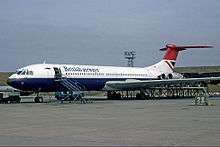
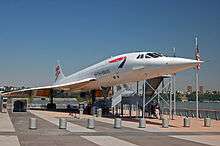
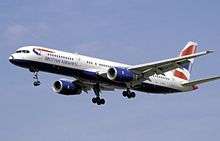
Former fleet
| Aircraft | Introduced | Retired |
|---|---|---|
| Airbus A320-100 | 1988 | 2007 |
| BAC One-Eleven 400 | 1974 | 1988 |
| BAC One-Eleven 500 | 1974 | 1993 |
| BAe 146–200 | 1989 | 1994 |
| BAe ATP | 1989 | 1994 |
| Boeing 707-300 | 1974 | 1984 |
| Boeing 707-400 | 1974 | 1981 |
| Boeing 737-200 | 1977 | 2001 |
| Boeing 737-300 | 1988 | 2009 |
| Boeing 737-400 | 1997 | 2015 |
| Boeing 737-500 | 1996 | 2009 |
| Boeing 747-100 | 1974 | 1999 |
| Boeing 747-200 | 1977 | 2001 |
| Boeing 757-200 | 1983 | 2010[111] |
| Aérospatiale-BAC Concorde | 1976 | 2003 |
| Hawker Siddeley Trident | 1974 | 1985 |
| Hawker Siddeley HS 748 | 1975 | 1989 |
| Lockheed Tristar 1 | 1975 | 1983 |
| Lockheed Tristar 200 | 1980 | 1991 |
| Lockheed Tristar 500 | 1979 | 1983 |
| McDonnell Douglas DC-10 | 1988 | 1999 |
| Vickers VC10 | 1974 | 1981 |
| Vickers Vanguard | 1974 | 1975 |
| Vickers Viscount | 1974 | 1982 |
British Airways Engineering
The company has its own engineering branch to maintain its aircraft fleet, this includes line maintenance at over 70 airports around the world.[112] As well as hangar facilities at Heathrow and Gatwick airport it has two major maintenance centres at Glasgow and Cardiff Airports.
Marketing
Branding
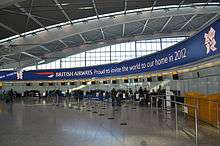

The musical theme predominantly used on British Airways advertising is "The Flower Duet" by Léo Delibes.[113] This, and the slogan "The World's Favourite Airline" were introduced in 1989 with the launch of the iconic "Face" advertisement.[114] The slogan was dropped in 2001 after Lufthansa overtook BA in terms of passenger numbers.[115] "Flower Duet" is still used by the airline, and has been through several different arrangements since 1989. The most recent version of this melody was shown in 2007 with a new slogan: "Upgrade to British Airways".[116] Other advertising slogans have included "The World's Best Airline", "We'll Take More Care of You", and "Fly the Flag".[117]
BA had an account for 23 years with Saatchi & Saatchi, an agency that created many of their most famous advertisements, including the influential "Face" campaign. Saatchi & Saatchi later imitated this advert for Silverjet, a rival of BA, after BA discontinued their business activities.[118] Since 2007 BA has used Bartle Bogle Hegarty as its advertising agency.[119]
British Airways purchased the internet domain ba.com in 2002 from previous owner Bell Atlantic, 'BA' being the company's acronym and its IATA Airline code. In 2011 BA launched its biggest advertising campaign in a decade, including a 90-second cinematic advert celebrating the airline's ninety-year heritage and a new slogan "To Fly. To Serve".[120]
British Airways is the official airline of the Wimbledon Championship tennis tournament, and was the official airline and tier one partner of the 2012 Summer Olympics and Paralympics.[121][122] British Airways was also the official airline of England's bid to host the 2018 Football World Cup.[123]
High Life, founded in 1973, is the official in-flight magazine of the airlines.[124]
Liveries and tail fins
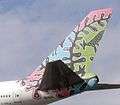
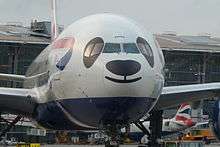
Since its formation in 1974, British Airways' aeroplanes carried a Union Jack scheme painted on their tail fins. The original tail scheme was changed in 1984 as part of a new livery designed by Landor Associates.[125]
In 1997, there was a controversial change from the use of the former British Airways branding (which incorporated stylised elements of the Union Jack) to a new livery which was intended mainly to reflect the diversity of places served by the airline – so-called "World Images". This involved a range of different designs appearing on tailfins and elsewhere, although the bodies of all the planes would use the corporate colours consistently; the exception was the Concorde fleet, which would have a new tailfin design based on a stylised, fluttering Union flag.[126] What became known as the "ethnic images" included Delftware or Chinese calligraphy, related to countries on the company's network of routes. This was reported to have caused problems with air traffic control: previously controllers had been able to tell pilots to follow a BA plane, but they were now harder to visually identify.[127] Several people spoke out against the change, including the former Prime Minister Margaret Thatcher, who famously covered the tail of a model 747 at an event with a handkerchief, to show her displeasure.[128] BA's traditional rival, Virgin Atlantic, took advantage of the negative press coverage by applying the Union flag to the winglets of their aircraft along with the slogan "Britain's national flagcarrier".[129] In 1999 the CEO of British Airways, Bob Ayling, announced that all BA planes would adopt the tailfin design originally intended to be used only on the Concorde, based on the Union Flag.[130]
Loyalty programmes
British Airways' tiered loyalty programme, called the Executive Club, includes access to special lounges and dedicated "fast" queues.[131] BA also invites its top corporate accounts to join a "Premier" incentive programme. British Airways operates airside lounges for passengers travelling in premium cabins, and these are available to certain tiers of Executive Club members.[132] First class passengers, as well as Gold Executive Club members, are entitled to use First Class Lounges. Business class passengers (called Club World or Club Europe in BA terms) as well as Silver Executive Club members may use Business lounges.[133] At airports in which BA does not operate a departure lounge, a third party lounge is often provided for premium or status passengers.[134] In 2011, due to the merger with Iberia, British Airways announced changes to the Executive Club to maximise integration between the airlines.[135] This included the combination and rebranding of Air Miles, BA Miles and Iberia Plus points as the IAG operated loyalty programme Avios.
Inflight magazines
high life Magazine is British Airways' complimentary inflight magazine. It is available to all customers across all cabins and aircraft types.
high life shop Magazine is British Airways' inflight shopping magazine. It is available to all customers on all aircraft where the inflight shopping range can be carried.
First life is a complimentary magazine offered to all customers travelling in the First cabin. It has a range of articles including fashion, trends and technology with an upmarket target audience.
Business life is a complimentary magazine targeted at business travellers and frequent flyers. The magazine can be found in all short haul aircraft seat pockets, in the magazine selection for Club World customers and in lounges operated by British Airways.
Cabins & Services
_March_2008.jpg)
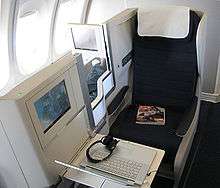
Short haul
Economy Class
UK Domestic is British Airways' economy class on domestic UK flights. Flights into Heathrow are mostly operated by Airbus A320 series aircraft – a small number of peak services to Glasgow and Edinburgh are operated by Boeing 767-300ERs configured in an all-economy layout. Flights into Gatwick are operated by Airbus A320 series aircraft in a one-class configuration. On flights departing before 09:30 a complimentary hot breakfast item is served with orange juice and tea or coffee. For all flights departing after 09:30 a complimentary bar service is offered along with a light snack item.
Euro Traveller is British Airways' economy class offering on flights from the UK to the rest of Europe.[136] Heathrow based flights are operated by the Airbus A320 series aircraft and Boeing 767-300ER aircraft. Gatwick based flights are operated by Airbus A320 series aircraft. Standard seat pitch varies from 29" to 34" depending on aircraft type and location of seat. Complimentary drinks and snacks are offered and vary depending on flight length and time of day. Longer services over three hours from Heathrow usually have a hot meal service.
Beginning on 11 January 2017 short haul flights (five or fewer hours of flight time) will switch to a buy on board system with Marks & Spencer products available for purchase.[137] Flights from London City Airport and London Stansted Airport will switch to buy on board in the summer of 2017. Passengers may also use Frequent Flyer Avios points to buy items.[138] Simon Calder of The Independent stated that this may cause an increase in terminal-based food establishments at London Heathrow Terminal 5.[139]
Business Class
Club Europe is the short-haul business class on all short-haul flights (excluding those within the UK). This class allows for access to business lounges at most airports.[140][141] Club Europe provides seats in a 2–2 configuration on narrowbody aircraft, with the middle seat not used. Instead, a table folds up from under the middle seat on refurbished aircraft.[11][142] Pillows and blankets are available on longer flights.
In-flight entertainment is offered on selected longer flights operated by the Boeing 767-300ER and some A320 aircraft.[143] Headphones are provided to all customers on services where IFE is available.
Mid-haul
In 2012, British Airways launched a new mid-haul product for the Airbus A321s on routes formerly operated by BMI. These aircraft have been designated to serve routes such as Almaty, Tbilisi, Baku, Cairo, Amman, Beirut and Tel Aviv.
Business
The 'Club World' business class on these narrowbody aircraft is slightly different from the product operated on the rest of the long-haul fleet: An alternating 1:2 / 2:1 configuration of 23 seats is used in the front section of the aircraft. The full Club World bar and main meal service is offered. Larger individual LCD TV screens are fitted to each seat back.
Economy
The 'World Traveller' service is also offered on these flights with complimentary drinks, food and individual IFE screens. All seats on the aircraft are fitted with the Thales i5000 or Rockwell Collins in-flight entertainment system.
Long haul
First class
First class is offered on all Airbus A380s, all Boeing 747-400s, some Boeing 777-200s, and all Boeing 777-300ERs and Boeing 787-9s on launch. There are fourteen (eight on 787-9) private "demi-cabins" on most of these aircraft, each with a 6 ft 6 in (1.98 m) bed, a 15-inch (38 cm) wide entertainment screen, and in-seat power.[144][145] Dedicated British Airways 'Galleries First' lounges are available at some airports. The exclusive 'Concorde Room' lounges at Heathrow Terminal 5 and New York JFK airports extend the offering with waiter service pre-flight dining and more intimate space. Business lounges are used where these are not available.
Business Class
Club World is the long-haul business class, and is offered on all long-haul configured Boeing 767, Boeing 777, Boeing 787, Boeing 747-400, Airbus A318 and A380 aircraft.[146][147] The cabin features fully flat beds. In 2006 British Airways launched Next Generation New Club World, featuring larger seats.[11] The Club World cabins are all configured in a similar design on widebody aircraft with aisle seats facing forwards while middle seats and window seats face backwards (British Airways is one of only three carriers with backwards facing Business class seats; American Airlines and United Airlines are the others).
Premium Economy
World Traveller Plus is the premium economy offering provided on all long-haul aircraft except the Airbus A318.[136] This cabin offers wider seats, extended leg-room, additional seat comforts such as larger IFE screen (on most aircraft) a foot rest and power sockets.[148] A complimentary 'World Traveller' bar is offered along with an upgraded main meal course.
Economy
World Traveller is the long-haul economy class offered on international flights to destinations outside Europe. It offers seat-back entertainment, complimentary drinks and meals.[136][149][150] AVOD is offered on all A380s, 747s, long-haul 767s, and all of the 777s and 787s.[151] On the Airbus A380, Boeing 787, Boeing 777-300ER and refurbished 777-200 aircraft, AC power outlets and USB plug-in points are offered in every seat row. The outlets accept both UK and US plugs. The outlets in World Traveller are located between each seat.
Incidents and accidents
- In November 1974, British Airways Flight 870 was hijacked shortly after take-off from Dubai for London Heathrow, The Vickers VC10 landed at Tripoli for refuelling before flying on to Tunis. The captain, Jim Futcher, returned to the aircraft to fly it knowing the hijackers were on board. The hijackers eventually surrendered after 84 hours, but not before a hostage was murdered. Futcher was awarded the Queen's Gallantry Medal, the Guild of Air Pilots and Air Navigators Founders Medal, the British Air Line Pilots Association Gold Medal and a Certificate of Commendation from British Airways for his actions during the hijacking.[152][153]
- On 10 September 1976, a Trident 3B on British Airways Flight 476 departed from London Heathrow to Istanbul. It collided in mid-air with an Inex Adria DC9-31 near Zagreb.[154] All 54 passengers and 9 crew members on the BA aircraft died. This is the only fatal accident to a British Airways aircraft since the company's formation in 1974.
- On 24 June 1982, British Airways Flight 9, a Boeing 747-200 registration G-BDXH, flew through a cloud of volcanic ash and dust from the eruption of Mount Galunggung. The ash and dust caused extensive damage to the aircraft, including the failure of all four engines.[155] The crew managed to glide the plane out of the dust cloud and restart all four of its engines, although one later had to be shut down again. The volcanic ash caused the cockpit window to be scratched to such an extent that it was difficult for the pilots to see out of the plane. However, the aircraft made a successful emergency landing at Halim Perdanakusuma International Airport just outside Jakarta. There were no fatalities or injuries.[156]
- On 10 June 1990, British Airways Flight 5390, a BAC One-Eleven flight between Birmingham and Málaga, suffered a windscreen blowout due to the fitting of incorrect bolts the previous day. The Captain, Tim Lancaster, suffered major injuries after being partially blown out of the aircraft, but the co-pilot landed the plane safely at Southampton Airport. Despite the physical trauma he suffered, Lancaster fully recovered, and five months later he returned to duty. The co-pilot never returned to flying due to the trauma he sustained.[157]
- On 2 August 1990, British Airways Flight 149 landed at Kuwait International Airport four hours after the Iraqi invasion of Kuwait. The aircraft, a Boeing 747-100 G-AWND, was destroyed, and all passengers and crew were captured. Two of the landing gears were salvaged, and are on display in Waterside, BA Headquarters in London.[158][159]
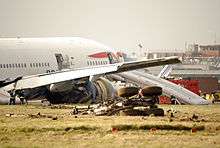
- On 29 December 2000, British Airways Flight 2069 was en route from London to Nairobi when a mentally-ill passenger entered the cockpit and grabbed the controls. As the pilots struggled to remove the intruder, the Boeing 747-400 stalled twice and banked to 94 degrees. Several people on board were injured by the violent manoeuvres, which briefly caused the aircraft to descend at 30,000 ft per minute. The man was finally restrained with the help of several passengers, and the co-pilot regained control of the aircraft. The flight landed safely in Nairobi.
- On 17 January 2008, British Airways Flight 38, a Boeing 777-200ER G-YMMM, from Beijing to London crash-landed approximately 1,000 feet (300 m) short of London Heathrow Airport's runway 27L, and slid onto the runway's displaced threshold. The aircraft sustained damage to its landing gear, wing roots and engines, resulting in the first hull loss of a Boeing 777. There were no fatalities, but there was one serious injury and 12 minor injuries. The accident was caused by icing in the fuel system, resulting in a loss of power.
- On 22 December 2013, British Airways Flight 34, a Boeing 747–436 G-BNLL, hit a building at O. R. Tambo International Airport in Johannesburg after missing a turning on a taxiway. The starboard wing was severely damaged but there were no injuries amongst the crew or 189 passengers, however four members of ground staff were injured when the wing smashed into the building.[160] The aircraft was officially withdrawn from service in February 2014.[161]
- On 8 September 2015, British Airways Flight 2276, a Boeing 777-236ER G-VIIO, aborted its takeoff at Las Vegas McCarran International Airport due to the uncontained engine failure [162] of its left (#1) General Electric GE90 engine, which led to a substantial fire. The aircraft was evacuated on the main runway. All 157 passengers and 13 crew escaped the aircraft, at least 14 people sustaining minor injuries.[163][164][165]
See also
- Air transport in the United Kingdom
- List of airports in the United Kingdom and the British Crown Dependencies
- Transport in the United Kingdom
- Plane Saver Credit Union
Notes
- ↑ On 31 December 2015 the active 737-400 fleet was zero, with six aircraft still owned by British Airways but not in service."2015 British Airways Annual Report". p. 72.
- ↑ On 31 December 2015 the active 747-400 fleet was 40, with 11 aircraft still owned by British Airways but not in service."2015 British Airways Annual Report". p. 72.
- ↑ On 31 December 2015 the active 767-300ER fleet was 12, with five aircraft still owned by British Airways but not in service."2015 British Airways Annual Report". p. 72.
References
- ↑ "IATA - Airline and Airport Code Search". iata.org. Retrieved 13 April 2015.
- ↑ Used for domestic flights
- ↑ Davies, Rob (6 November 2015). "British Airways: Alex Cruz to replace Keith Williams as chairman". The Guardian. Retrieved 11 November 2015.
- ↑ "IAG Full Year Results 2015" (PDF). International Consolidated Airlines Group. Retrieved 25 March 2016.
- 1 2 "Explore our past: 1970–1979". British Airways. Retrieved 6 July 2013.
- ↑ "UK abandons long-haul competition". Flight International. 7 August 1975. p. 173.
- ↑ "Concorde starts regular service". Eugene Register-Guard. 26 January 1976. Retrieved 27 June 2010.
- 1 2 "Explore Our Past:2000 – present". British Airways. Retrieved 20 June 2010.
- ↑ Thackray, Rachelle (12 February 1998). "A-Z of Employers". The Independent. Archived from the original on 2 November 2012. Retrieved 27 June 2010.
- ↑ Marshall, Tyler (24 October 1992). "After much fanfare, sale of British Airways set to begin". The Independent. London.
- 1 2 3 4 5 "Explore our past: 1980–1989". British Airways. Retrieved 8 June 2010.
- 1 2 "BA dirty tricks against Virgin cost £3m". BBC: On This Day. 11 January 1993. Retrieved 23 October 2006.
- 1 2 3 "Explore our past: 1990–1999". British Airways. Retrieved 8 June 2010.
- ↑ "International Business; British Airways Ousts Chief After Four Tumultuous Years". The New York Times. 11 March 2000. Retrieved 13 June 2009.
- ↑ Sorkin, Andrew (29 August 1999). "Market Insight: Seeing Fool's Gold In Airlines' Cheap Seats". The New York Times. Retrieved 27 June 2010.
- ↑ "Airlines aim for merger". BBC News. 13 July 2000. Retrieved 16 July 2013.
- ↑ "Airlines end merger plans". BBC News. 21 September 2000. Retrieved 16 July 2013.
- ↑ "BA sells Go for £100m". BBC News. 14 June 2001. Retrieved 16 July 2013.
- ↑ "BA to sell off 18% Qantas stake". BBC News. 8 September 2004. Retrieved 10 July 2013.
- ↑ Lavery, Brian (9 March 2005). "International Business; Former Chief of Aer Lingus To Get British Air's Top Post". The New York Times. Retrieved 27 June 2010.
- ↑ Jemima Bokaie (9 January 2008). "BA brands new airline 'Open Skies'". Brand Republic. Retrieved 27 June 2010.
- ↑ Brothers, Caroline (30 July 2008). "British Airways in Merger Talks". The New York Times. Retrieved 30 July 2008.
- 1 2 3 "British Airways and Iberia sign merger agreement". BBC News. 8 April 2010. Retrieved 23 October 2011.
- ↑ Rowley, Emma (15 July 2010). "EC approves BA alliance with American Airlines and Iberia". The Telegraph. London. Retrieved 15 July 2010.
- ↑ Kamal Ahmed (14 February 2010). "British Airways given approval for tie up with American Airlines and Iberia". The Telegraph. Retrieved 15 July 2013.
- ↑ Wilson, Elliot (14 July 2010). "British Airways' three-way alliance cleared for takeoff". Daily Mail. London. Retrieved 16 July 2010.
- ↑ "Airlines unveil 'new deal for transatlantic flyers'". The Independent. London. 8 October 2010. Retrieved 8 October 2010.
- ↑ "Iberia expects to complete merger with British Airways in January". Daily Nation. 27 October 2010. Retrieved 18 November 2010.
- ↑ "BA and Iberia agree merger deal". BBC News. 12 November 2009. Retrieved 23 October 2011.
- ↑ "British Airways trades for last time ahead of Iberia merger". The Guardian. UK. 20 January 2011. Retrieved 21 January 2011.
- ↑ Wearden, Graeme (6 September 2010). "British Airways most likely to buy LAN Airlines first – Paddy Power". The Guardian. London. Retrieved 6 September 2010.
- ↑ "Lufthansa and IAG reach agreement in principle on the sale of British Midland Ltd." (Press release). Deutsche Lufthansa AG. 4 November 2011. Retrieved 2 December 2011.
- ↑ Alistair Osborne & Amy Wilson (22 December 2011). "British Airways owner IAG seals deal to buy BMI for £172.5m". The Telegraph. Retrieved 1 January 2012.
- ↑ Douglas Fraser (30 March 2012). "Is British Airways giving up enough to buy BMI?". BBC News. Retrieved 3 April 2012.
- ↑ David Kaminski-Morrow (13 June 2012). "BA to operate A318 on new flight". Flightglobal. Retrieved 12 September 2012.
- ↑ Claire Heald (18 May 2012). "Olympic torch: Flame arrives in UK for 2012 torch relay". BBC News. Retrieved 15 July 2013.
- ↑ "British Airways Traffic Statistics 2008". British Airways. Retrieved 16 July 2010.
- ↑ "Passenger statistics for December 2008". EasyJet. Retrieved 24 February 2008.
- ↑ "Description of UK Civil Aviation Authority Type A Operating Licence". Civil Aviation Authority. Archived from the original on 11 March 2007. Retrieved 5 September 2009.
- ↑ "About British Airways – Waterside". British Airways. Retrieved 27 February 2010.
- ↑ "World Airline Directory: 26 March – 1 April 1997". Flight International. 26 March 1997. Retrieved 3 October 2010.
- ↑ Willcock, John. "People and Business: Toy story is just a fable." The Independent. Wednesday 7 October 1998. Retrieved 27 February 2010. "This is a lot more complimentary than the nickname for BA's old head office, Speedbird House, universally known as "Birdseed House". How cheap."
- ↑ "Flights hit by BA sale to Flybe". BBC News. 5 March 2007. Retrieved 23 October 2011.
- ↑ Gow, David (21 January 2004). "BA outbid for Heathrow slots". The Guardian. UK. Retrieved 23 October 2011.
- ↑ "Destinations and airlines". 2013. Retrieved 6 July 2013.
- ↑ "British Airways CEO insists flights over Iraq are safe". The UK News. Retrieved 2 August 2014.
- ↑ "BA CityFlyer to add one more Embraer 190 jet to its fleet". The-european.eu. 28 March 2012. Retrieved 7 October 2012.http://www.embraer.com/en-US/ImprensaEventos/Press-releases/noticias/Pages/BA-CITYFLYER-ACRESCENTA-MAIS-UM-JATO-EMBRAER-190-A-SUA-FROTA.aspx
- ↑ "About BA CityFlyer". Bacityflyerjobs.com. 2013. Retrieved 6 July 2013.
- ↑ "BA plans major expansion at London City". easier Travel. 14 March 2007. Retrieved 23 October 2011.
- ↑ Jameson, Angela (9 March 2015). "British Airways a good pick for Qatar". The National. Retrieved 12 March 2015.
- ↑ "SDR Helicopters Acquires British Airways Helicopters Privatised by British Airways PLC". Alacra Store. 23 September 1986. Retrieved 28 June 2010.
- ↑ Harrison, Michael (3 June 2003). "BA pays £49m to offload loss making Deutsche BA". The Independent.
- ↑ Nundy, Julian (29 April 1994). "British Airways, flying in the face of French pride". The Independent.
- ↑ "History of BAFC". Airways Aero Associations. Archived from the original on 11 March 2008. Retrieved 11 September 2009.
- ↑ "BA franchising forays into South Africa". Flight International. 19 June 1996. Retrieved 23 October 2011.
- ↑ Kingsley-Jones, Max (15 May 1996). "BA's franchising goes offshore". Flightglobal. Retrieved 23 October 2011.
- ↑ "Completion of acquisition by Flybe of BA connect". Flybe. 5 March 2007. Archived from the original on 25 February 2008.
- ↑ "Ownership & Structure". Eurostar. Retrieved 5 September 2009.
- ↑ "Eurostar restructure sees UK expand rail stake". AllRailJobs.co.uk. Retrieved 18 November 2015.
- ↑ "BA to launch 'open skies' airline". BBC News. 9 January 2008. Retrieved 23 October 2011.
- ↑ Done, Kevin (28 July 2008). "BA takes OpenSkies to Amsterdam". Financial Times. Retrieved 31 July 2008.
- ↑ Kaminski-Morrow, David. "Exclusive: British Airways A318 all-business cabin revealed". Flightglobal. Retrieved 23 October 2011.
- ↑ "British Airways orders two Airbus A318s to launch London City-New York route". Forbes. Archived from the original on 30 May 2008. Retrieved 27 May 2008.
- ↑ "British Airways Picks A318 Over Boeing 717 For Narrowbody Purchase". aeroworldnet.com. Archived from the original on 18 June 2008. Retrieved 12 September 2009.http://www.pprune.org/cabin-crew-wannabes/print-264389-ba-cityflyer-3.html
- ↑ "BA All Business Flights to Include Westbound Fuel Stop in Shannon Airport, Republic of Ireland.". Flightglobal. Retrieved 23 October 2011.
- ↑ "BA World Cargo Adds to Surcharge". Traffic World. 25 August 2005.
- ↑ "Atlas Air invests in new UK airline". Atlas Air Inc. (Press release). 12 April 2001. Archived from the original on 26 February 2003. Retrieved 19 December 2006.
- ↑ "BA Annual Report 2008" (PDF). British Airways Plc. Retrieved 18 November 2015.
- 1 2 3 "BA Annual Report 2010" (PDF). British Airways Plc. Retrieved 18 November 2015.
- 1 2 "BA Annual Report 2011". British Airways Plc. Retrieved 18 November 2015.
- 1 2 "BA Annual Report 2013". British Airways Plc. Retrieved 18 November 2015.
- ↑ "BA Annual Report 2014". British Airways Plc. Retrieved 18 November 2015.
- ↑ "BA Annual Report 2015". British Airways Plc. Retrieved 16 April 2016.
- 1 2 Milmo, Dan (15 December 2009). "BA strike: conflict that was always on airline's flight path". The Guardian. London. Retrieved 4 July 2010.
- ↑ Bamber, G.J., Gittell, J.H., Kochan, T.A. & von Nordenflytch, A. (2009). "chapter 5". Up in the Air: How Airlines Can Improve Performance by Engaging their Employees. Cornell University Press, Ithaca. Retrieved 18 November 2015.
- ↑ "Gate Gourmet probes union claims". BBC News. 18 August 2005. Retrieved 23 October 2011.
- ↑ "Woman to sue BA in necklace row". BBC News. 15 October 2006. Retrieved 23 October 2011.
- ↑ Cockcroft, Lucy (19 January 2010). "BA 'wrong' to ban Christian from wearing cross because it 'plays into extremists' hands'". The Telegraph.
- ↑ Merrick, Jane; Sam Greenhill (24 November 2006). "Jack Straw joins chorus of condemnation over BA's 'cross' ban". Daily Mail.
- ↑ "British Airways cabin crew vote for Christmas strike". BBC News. 14 December 2009. Retrieved 24 October 2011.
- ↑ "BA Strikers to forfeit cheap travel perks". BBC News. 24 March 2010. Retrieved 24 October 2011.
- ↑ "Apology to Frank Burchill". The Guardian. 2 April 2010. Retrieved 6 June 2010.
- ↑ "Right to Work conference shows opposition to BA boss Willie Walsh". Socialist Worker. 22 May 2010. Retrieved 6 June 2010.
- ↑ "Unite union says BA strike to go ahead". BBC News. 23 May 2010. Retrieved 16 July 2010.
- ↑ Smith, Patrick (10 July 2009). "Ask the Pilot: Welcome to the Six Continent Club!". Salon. Archived from the original on 14 July 2009. Retrieved 25 October 2009.http://www.salon.com/2009/07/10/askthepilot326/
- ↑ "Profile on British Airways". CAPA. Centre for Aviation. Archived from the original on 2016-11-01. Retrieved 2016-11-01.
- ↑ "CAA Aircraft Register (Boeing aircraft registered to British Airways)". Civil Aviation Authority. Retrieved 5 September 2009.
- ↑ "Boeing and British Airways complete deal for four 777-200ERs; Boeing 777 is logical complement to British Airways' wide-body fleet". M2 Presswire. 28 March 2007. Retrieved 28 June 2010.
- ↑ "Rolls-Royce lands US jets deal". Birmingham Evening Mail. 18 August 1998. Retrieved 18 November 2015 – via Highbeam. (subscription required (help)).
- ↑ Howard Mustoe; Steve Rothwell. "British Airways Picks Troubled Rolls Engine for A380s". Bloomberg. Retrieved 15 July 2013.
- ↑ "BA opts for A380 and Dreamliner". BBC News. 27 September 2007. Retrieved 27 September 2007.
- ↑ Dunkley, Jamie (1 August 2008). "BA warns that ticket prices will jump as routes are axed". The Daily Telegraph. London. Retrieved 1 August 2008.
- ↑ "IAG to order 18 A350s for BA". Flightglobal.com. 22 April 2013. Retrieved 29 July 2014.
- ↑ "Airbus A350 for British Airways", Airliner World, p. 5, June 2013
- ↑ Ellison, Marc (2 September 2013). "BA Dreamliner completes inaugural London-Toronto flight". Toronto Star. Retrieved 13 September 2013.
- ↑ "BA's first A380 superjumbo arrives at Heathrow airport". BBC News. Retrieved 4 July 2013.
- ↑ Wall, Robert. "British Airways to Fly First A380s to Los Angeles, Hong Kong". Bloomberg. Retrieved 5 March 2013.
- ↑ "United Kingdom Civil Aircraft Register". United Kingdom Civil Aviation Authority. 17 September 2016. Retrieved 18 September 2016.
- ↑ "British Airways Fleet Facts". British Airways. Retrieved 17 September 2015.
- 1 2 "IAG orders 20 A320neo Family aircraft | Airbus Press release". Airbus.com. Retrieved 29 July 2014.
- 1 2 "AIRBUS A320 neo FAMILY FIRM ORDERS". airbus.com. Archived from the original on 14 February 2015. Retrieved 22 February 2015.
- 1 2 "Archived copy". Archived from the original on 12 March 2016. Retrieved 5 March 2016.
- ↑ Airbus (30 April 2014). "Airbus – Orders and Deleveries April 2014". Toulouse: Airbus. Retrieved 3 June 2014.
- 1 2 3 "Boeing 787 Orders and Deliveries". The Boeing Company. 30 April 2016. Retrieved 24 May 2016.
- ↑ "IAG Cargo signs freight deal with Qatar Airways". IAG Cargo. 17 January 2014. Retrieved 21 January 2014.
- ↑ "BA Cargo Vickers 963C". Airliners.net. 9 October 2011. Retrieved 7 October 2012.
- ↑ "BA Cargo 707-330C". Airliners.net. 6 May 1980. Retrieved 7 October 2012.
- ↑ "BA Cargo 747-200F". Airliners.net. 21 January 2001. Retrieved 7 October 2012.
- ↑ "BA Cargo World Tails 747-400F". Airliners.net. 23 October 1999. Retrieved 7 October 2012.
- ↑ Rohit T.K. (17 January 2014). "Atlas Air loses contract with British Airways, shares dive". Reuters. Retrieved 21 January 2014.
- ↑ Max Kingsley-Jones (31 October 2010). "BA's last Boeing 757 bows out in style". Aviation Week. Retrieved 15 July 2013.http://www.globalaviationresource.com/reports/2010/ba757retirement.php
- ↑ "British Airways Engineering". Britishairways.com. Retrieved 2 November 2011.
- ↑ "Flower Duet (From Lakme) by Leo Delibes". Chris Worth Productions. Retrieved 8 June 2007.
- ↑ "1989 British Airways Commercial". YouTube. Retrieved 19 January 2008.
- ↑ "British Airways takes off". CNN. 22 May 2001. Retrieved 28 June 2010.
- ↑ "BA official website – "Upgrade to British Airways" homepage". British Airways. Retrieved 14 September 2009.
- ↑ "BA slogan out of favour". The Herald. 30 April 1999.
- ↑ Sweney, Mark (5 October 2007). "Saatchi ad gets revenge on BA". The Guardian. UK. Retrieved 28 June 2010.
- ↑ "Clients & Work". Bartle Bogle Hegarty. Retrieved 27 September 2007.
- ↑ Ray Massey (21 September 2011). "British Airways relaunches itself with new slogan that nods to its imperial origins". Daily Mail. Retrieved 6 July 2013.
- ↑ "British Airways Reminds Visitors to Leave Air Horn, Chili Dog at Home During Wimbledon". Agency.com. Retrieved 5 September 2009.
- ↑ "British Airways – official airline partner of London 2012". British Airways. Retrieved 22 June 2010.
- ↑ "BA part of 2018 World Cup History". 27 April 2010. Retrieved 28 June 2010.
- ↑ "First Life". Cedarcom.co.uk. Retrieved 29 July 2014.
- ↑ Moseley, Ray (12 January 1986). "British Airways scores big profit turnaraound". Chicago Tribune.
- ↑ Aldersey-Williams, Hugh (15 June 1997). "By their tailfins shall we know them?". The Independent. London. Retrieved 28 June 2010.
- ↑ Willcock, John (9 April 1998). "People & Business". The Independent. London. Retrieved 28 June 2010.
- ↑ "BA turns tail on colours". BBC News. 11 May 2001. Retrieved 6 July 2013.
- ↑ Parsons, Tony (14 June 1999). "Tony Parsons' column: Don't Jack it in yet". The Mirror. Retrieved 28 June 2010.
- ↑ Mansell, Warwick (7 June 1999). "Union Jack is back on the world's favourite airline". The Independent. London. Retrieved 28 June 2010.
- ↑ Bown, Jessica (30 April 2006). "Now you can fly further with air loyalty plans". The Times. London. Retrieved 13 June 2009.
- ↑ "Lounges". British Airways. Retrieved 17 September 2009.
- ↑ "First Lounges". British Airways. Retrieved 24 August 2010.
- ↑ "Lounge locations". British Airways. Retrieved 17 September 2009.
- ↑ Lythe, Ruth (10 October 2011). "The great Airmiles rip-off... or how thousands of families will lose the trip of a lifetime". Daily Mail.
- 1 2 3 "British Airways seat-pitch guide". Skytrax. Retrieved 5 June 2010.http://www.airlinequality.com/info/seat-pitch-guide/
- ↑ "British Airways to charge for inflight food and drink on European flights: What will it mean for passengers?". The Independent. 29 September 2016. Retrieved 2 October 2016.
- ↑ "BRITISH AIRWAYS AND MARKS & SPENCER JOIN FORCES TO PROVIDE BEST FOOD IN THE SKY FOR SHORT-HAUL CUSTOMERS" (Press release). British Airways. 29 September 2016. Retrieved 28 October 2016.
- ↑ Calder, Simon (30 September 2016). "No more free food on BA's short haul flights – so what's in store for Heathrow Terminal 5?". The Independent. Retrieved 2 October 2016.
- ↑ "Club Europe: Lounges". British Airways. Retrieved 5 September 2009.
- ↑ "Club Europe: In-flight dining". British Airways. Retrieved 5 September 2009.
- ↑ "Wider seats in Club Europe". British Airways. Retrieved 5 September 2009.
- ↑ "Euro Traveller: On-board". British Airways. Retrieved 5 September 2009.
- ↑ "British Airways 2007/08 Annual Report and Accounts". British Airways. Retrieved 3 April 2009.
- ↑ Haslam, Chris (31 January 2010). "Times report on BA First Class". The Times. London. Retrieved 1 April 2010.
- ↑ "Club World: On arrival". British Airways. Retrieved 5 September 2009.
- ↑ "Club World: Lounges". British Airways. Retrieved 5 September 2009.
- ↑ "World Traveller Plus Information". British Airways. Retrieved 5 June 2010.
- ↑ "World Traveller Information". British Airways. Retrieved 5 June 2010.
- ↑ "World Traveller – Preview our new Cabin". British Airways. Retrieved 31 August 2010.
- ↑ "World Traveller Entertainment".
- ↑ "Four Hijackers Surrender; Tunisian Aide Denies Deal; Passengers in London". The New York Times. 26 November 1974. Retrieved 28 June 2010.http://query.nytimes.com/gst/abstract.html?res=9F0DE4DF103BE63BBC4E51DFB767838F669EDE
- ↑ "Captain Jim Futcher". The Telegraph. London. 31 May 2008. Retrieved 31 May 2008.
- ↑ "Worst midair crash ever claims 176 in Yugoslavia". Milwaukee Sentinel. 11 September 1976. Retrieved 28 June 2010.
- ↑ "Jet Safe After Heart-Stopping, Dead-Engine Dive". Los Angeles Times. 25 June 1982. Retrieved 28 June 2010.
- ↑ Faith, Nicholas (1998) [1996]. Black Box. Boxtree. p. 156. ISBN 0-7522-2118-3.
- ↑ "This is your captain screaming (interview with Nigel Ogden)". The Sydney Morning Herald. 5 February 2005. Retrieved 21 April 2008.
- ↑ "BA loses Iraq hostage appeal". BBC News. 15 July 1999. Retrieved 2 January 2010.
- ↑ "UK hostages describe Kuwait ordeal". BBC News. 16 October 2006. Retrieved 2 January 2010.
- ↑ "British Airways plane collides with building at Johannesburg airport". The Daily Telegraph. 22 December 2013. Retrieved 23 December 2013.
- ↑ "British Airways B74i7-400 G-BNLL Officially Withdrawn.". The BA Source. 22 February 2014. Retrieved 23 February 2014.
- ↑ "NTSB Issues Update on the British Airways Engine Fire at Las Vegas". NTSB. Retrieved 10 September 2015.
- ↑ "British Airways blaze pilot: 'I'm finished flying'". BBC News. Retrieved 18 November 2015.
- ↑ "British Airways plane catches fire in Las Vegas". BBC. 9 September 2015. Retrieved 9 September 2015.
- ↑ "British Airways fire: Jet's suppression system didn't work, source says". CNN. 9 September 2015. Retrieved 9 September 2015.
Bibliography
- British Airways (1974). British Airways annual report and accounts. British Airways Board.
- Campbell-Smith, Duncan (1986). The British Airways Story: Struggle for Take-Off. Hodder and Stoughton. ISBN 0-340-39495-1.
- Corke, Alison (1986). British Airways: the path to profitability. Pan. ISBN 0-330-29570-5.
- Gregory, Martyn (1996). Dirty tricks: British Airways' secret war against Virgin Atlantic. Warner. ISBN 0-7515-1063-7.
- Hayward, Keith (1983). Government and British civil aerospace: a case study in post-war technology policy. Manchester University Press. ISBN 0-7190-0877-8.
- Marriott, Leo (1998). British Airways. Plymouth Toy & Book. ISBN 1-882663-39-X.
- Penrose, Harald (1980). Wings Across the World: An Illustrated History of British Airways. Cassell. ISBN 0-304-30697-5.
External links
![]() Media related to British Airways at Wikimedia Commons
Media related to British Airways at Wikimedia Commons
- Official website (Mobile)
- British Airways Heritage Collection
- British Airways route map
- British Airways Flight Training